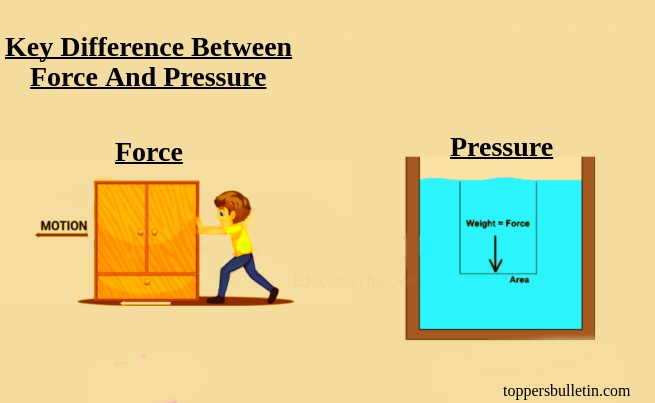Force and pressure are two fundamental concepts in physics that govern the behavior of objects and fluids in our world. They play a crucial role in understanding the mechanics of motion and the behavior of various materials under different conditions. In this article, we delve into the definitions and applications of force and pressure, key differences between force and pressure.
Difference between Force And Pressure
Here’s a comparison chart of Force Vs Pressure:
| Aspect | Force | Pressure |
|---|---|---|
| Definition | A push or pull applied to an object | Force exerted on a surface per unit area |
| Nature | Vector quantity (magnitude and direction) | Scalar quantity (magnitude only) |
| Measurement Units | Newton (N) | Pascal (Pa) |
| Transmission in Fluids | Acts directly on objects and solids | Equally transmitted in all directions in fluids |
| Application | Governs motion and dynamics of objects | Supports objects, transmits forces in fluids, causes deformations |
| Direction of Action | Determines direction of motion/deformation | Acts perpendicularly to the surface |
| Relationship with Area | Independent of the area of application | Directly related to the area over which the force is distributed |
| Instruments for Measurement | Spring scales, dynamometers, load cells | Barometers, manometers, pressure gauges |
| Everyday Examples | Pushing a car, pulling brakes, kicking a ball | Pressure in car tires, water hose, gas cylinder |
| Interrelation | Force can cause pressure when acting on an area | Pressure distribution results from force application |
What is Force
Force can be described as a push or pull that acts on an object, resulting in its acceleration or deceleration. It is a vector quantity, characterized by both magnitude and direction. When a force is applied to an object, it can cause a change in its state of motion. For instance, pushing a car will set it in motion, and pulling the brakes will cause it to stop. The standard unit of force is the Newton (N) in the International System of Units (SI).
What is Pressure
Pressure, on the other hand, refers to the force exerted on a surface per unit area. It is a scalar quantity and is measured in pascals (Pa) in the SI system. Pressure is a critical parameter in understanding various phenomena, such as supporting objects, transmitting forces in fluids, and causing deformations. When an area experiences a higher force over a smaller surface, the pressure is greater, and vice versa.
Calculation of Pressure:
Pressure can be quantified using a simple formula:
Pressure = Force / Area
Where “Force” represents the pushing or pressing force applied to the object, and “Area” denotes the surface area over which the force is distributed. The unit of pressure is the Pascal (Pa) in the International System of Units (SI).
Key Differences Between Force and Pressure
The difference between force and pressure points given below:
- Force is a push or pull causing acceleration between two bodies.
- Pressure is force spread over an area, acting perpendicularly to the surface.
- Force is measured in Newtons (N) and equals one kg-m/s².
- Pressure is measured in Pascals (Pa) and equals one N/m².
- Dynamometer measures force, torque, or power.
- Manometer measures pressure.
- Force is a vector with magnitude and direction.
- Pressure is a scalar with only magnitude.
- Force can act on faces, edges, or vertices.
- Pressure is applied only to the face.
- Force can change an object’s velocity in one direction.
- Pressure cannot change an object’s velocity.
Conclusion
In conclusion, force and pressure are foundational concepts that govern the mechanics of motion and the behavior of fluids and materials. Force acts as a push or pull on an object, while pressure measures the force distributed over a specific area. These principles find applications in a wide array of fields, ranging from engineering and physics to everyday life. Understanding force and pressure enriches our comprehension of the world around us and empowers us to create more efficient and effective systems and technologies.
Frequently Asked Questions (FAQs)
What is force?
Force is a push or pull applied to an object, causing it to accelerate or decelerate.
What is pressure?
Pressure is the force exerted on a surface per unit area.
How is force measured?
Force is measured in Newtons (N) using instruments like spring scales, dynamometers, or load cells.
What is the SI unit of pressure?
The SI unit of pressure is the Pascal (Pa), equivalent to one Newton per square meter (N/m²).
What is a dynamometer used for?
A dynamometer is used to measure force, torque (moment of force), or power.
What is a manometer used for?
A manometer is used to measure pressure, especially in fluids.
What is the difference between force and pressure?
Force is a vector quantity with both magnitude and direction, while pressure is a scalar with only magnitude.
Can pressure change an object’s velocity?
No, pressure cannot change an object’s velocity; it only acts perpendicularly on the surface it is applied to.
Where is force applied in an object?
Force can be applied to the face, edges, or vertices of an object.
Where is pressure applied in an object?
Pressure is applied only to the face of an object.

